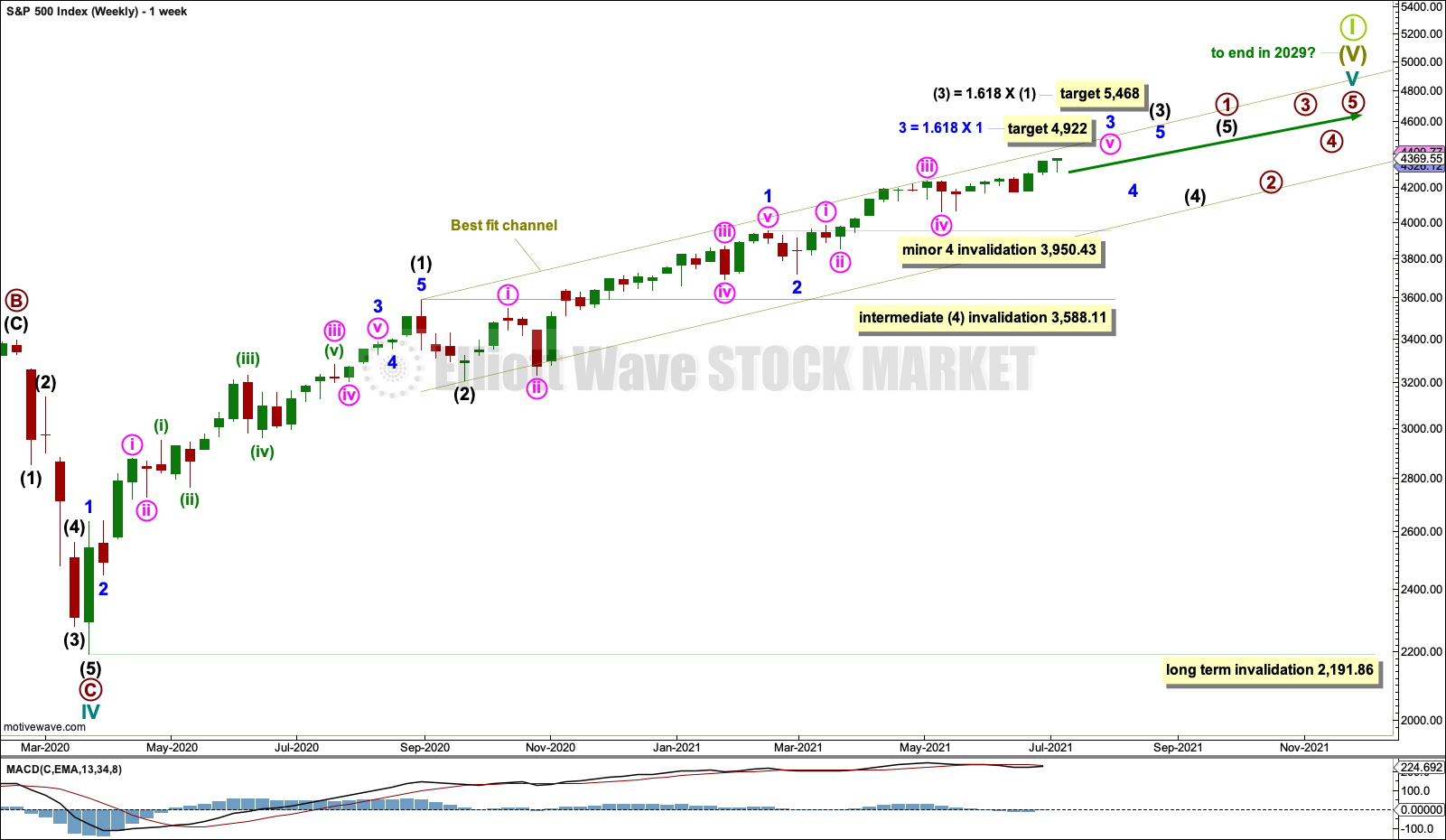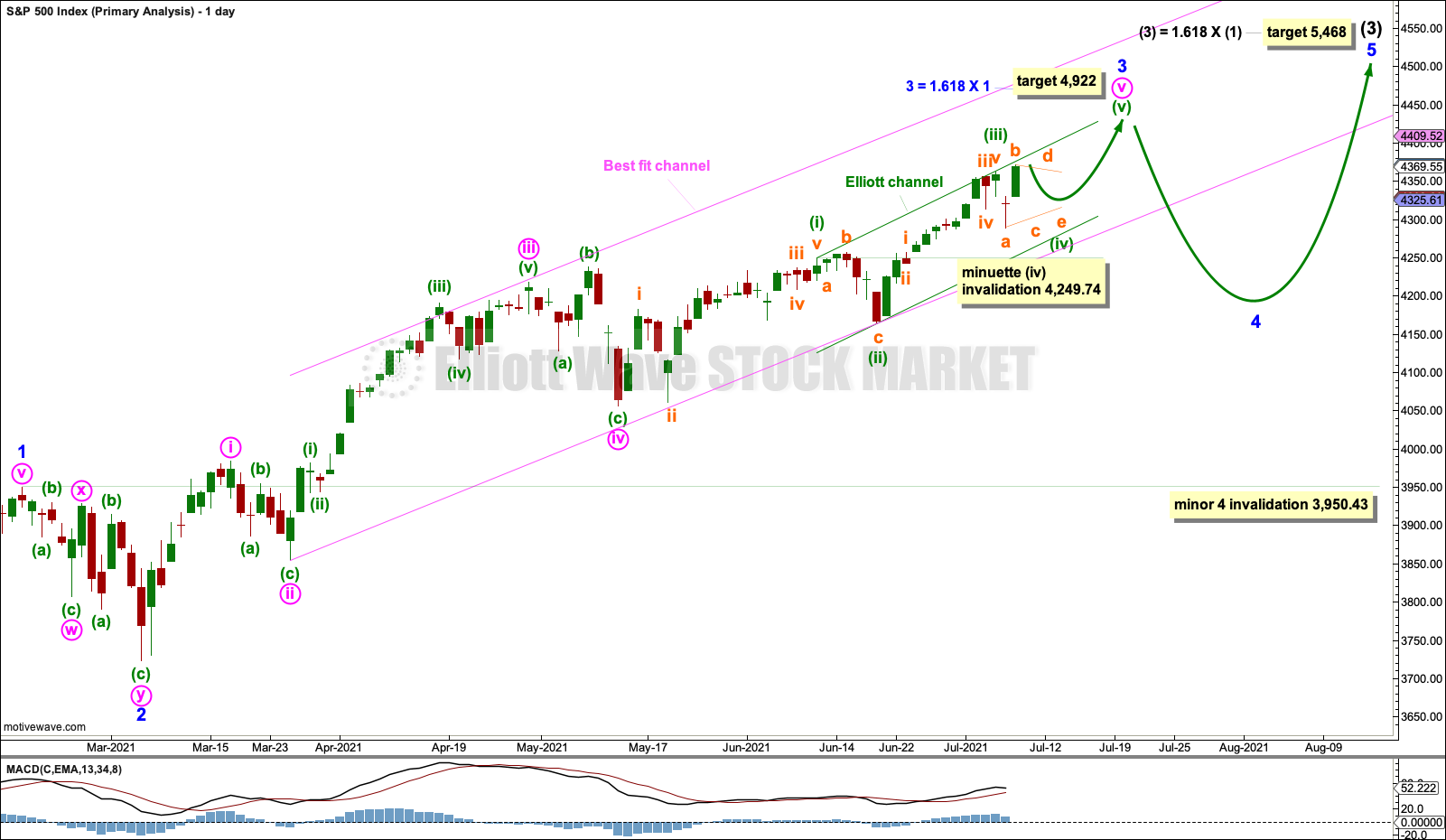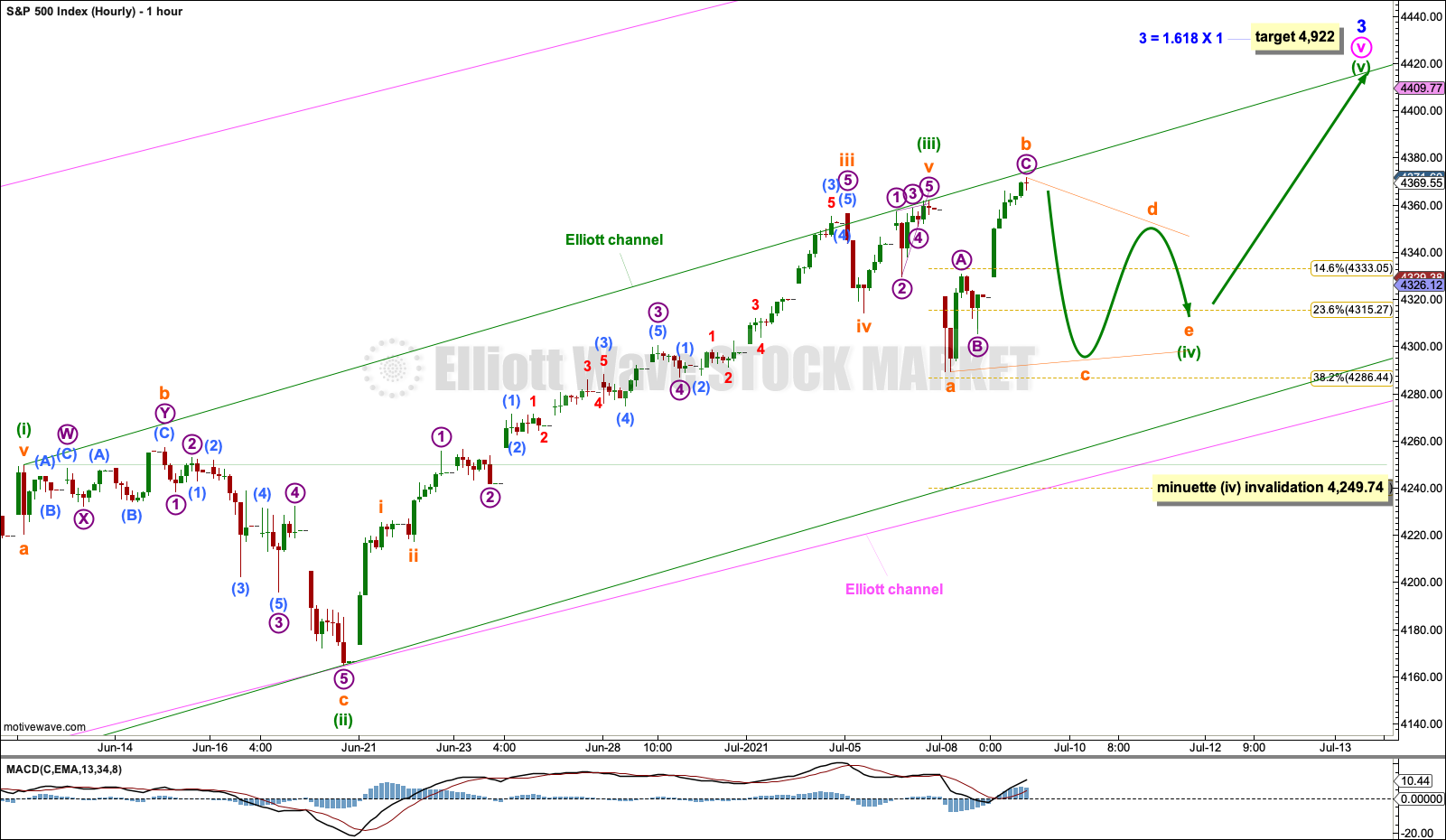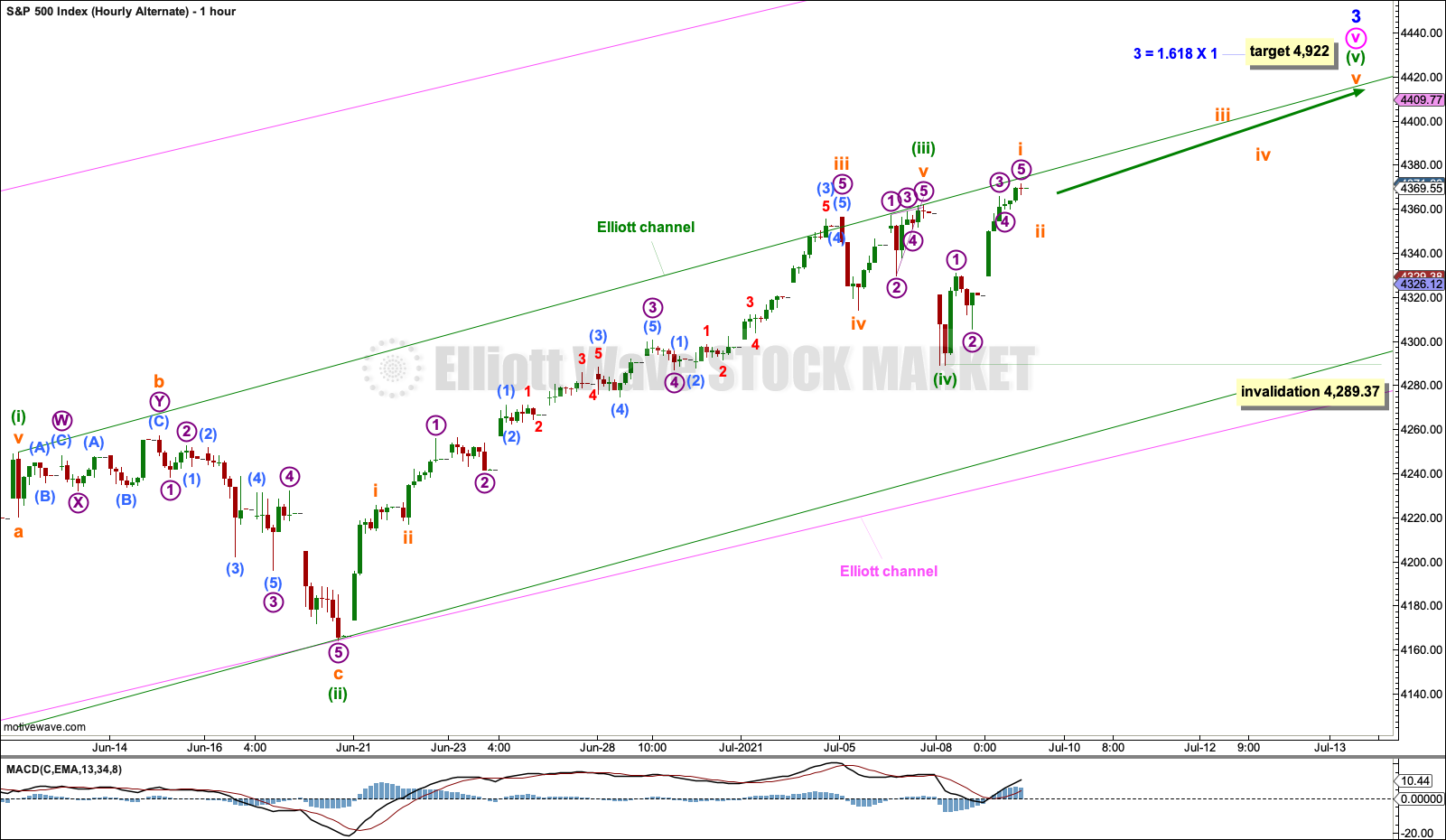S&P 500: Elliott Wave and Technical Analysis | Charts – July 9, 2021
Summary: The primary trend remains up. Pullbacks are a normal and to be expected part of a bull market.
Targets for the Elliott wave count: mid term 4,922 and long term 5,468.
For the short term, price may continue sideways for another one to three weeks. A new low below 4,289.37 would indicate a slightly deeper pullback, which may end about the lower edge of the green Elliott channel.
Risk management advice: Only the most experienced traders should attempt to trade against the larger trend. Others would best see corrections as buying opportunities when price is close to or at support. The trend is your friend.
The biggest picture, Grand Super Cycle analysis, is here.
Monthly charts are last updated here with video here.
MAIN ELLIOTT WAVE COUNT
WEEKLY CHART
Cycle wave V may last from one to several years. So far it is in its sixteenth month.
This wave count may allow time for the AD line to diverge from price as price makes final highs before the end of the bull market. The AD line most commonly diverges a minimum of 4 months prior to the end of a bull market. A longer divergence is positively correlated with a deeper bear market. A shorter divergence is positively correlated with a more shallow bear market. With zero divergence at this stage, if a surprise bear market does develop here, then it would likely be shallow.
A longer divergence between price and the AD line would be expected towards the end of Grand Super Cycle wave I.
It is possible that cycle wave V may continue until 2029, if the 2020s mirror the 1920s. Either March or October 2029 may be likely months for the bull market to end.
Cycle wave V would most likely subdivide as an impulse. But if overlapping develops, then an ending diagonal should be considered. This chart considers the more common impulse.
There is already a Fibonacci ratio between cycle waves I and III within Super Cycle wave (V). The S&P500 often exhibits a Fibonacci ratio between two of its actionary waves but rarely between all three; it is less likely that cycle wave V would exhibit a Fibonacci ratio. The target for Super Cycle wave (V) to end would best be calculated at primary degree, but that cannot be done until all of primary waves 1, 2, 3 and 4 are complete.
Primary wave 1 within cycle wave V may be incomplete. This gives a very bullish wave count, expecting a long duration for cycle wave V which has not yet passed its middle strongest portion.
Within primary wave 1: Intermediate waves (1) and (2) may be complete, and intermediate wave (3) may now be approaching an end.
Minor waves 1 and 2 within intermediate wave (3) may be complete. A target is calculated for intermediate wave (3) that expects a common Fibonacci ratio to intermediate wave (1).
Intermediate wave (4) may not move into intermediate wave (1) price territory below 3,588.11.
Within intermediate wave (3), minor waves 1 and 2 may be complete. A target is calculated for minor wave 3 to reach a common Fibonacci ratio to minor wave 1.
A best fit channel is drawn about cycle wave V. Draw the first trend line from the end of intermediate wave (1) to the end of minute wave iii within minor wave 3, then place a parallel copy on the end of intermediate wave (2). The channel may need to be redrawn as price continues higher. The channel may show where price may find resistance and support along the way up.
When primary wave 1 may be complete, then a multi-month pullback or consolidation may unfold for primary wave 2. It is possible that primary wave 2 may meet the technical definition of a bear market; it may correct to 20% or more of market value.
Primary wave 2 may not move beyond the start of primary wave 1 below 2,191.86.
DAILY CHART
The daily chart focusses on minor wave 3 within intermediate wave (3). This labelling fits with MACD.
Within minor wave 3: Minute waves i, ii, iii and iv may all be complete, and minute wave v may be extending.
Within minute wave v: Minuette waves (i), (ii) and (iii) may be complete, and minuette wave (iii) exhibits an increased slope. Minuette wave (ii) is labelled as an expanded flat. Minuette wave (iii) is slightly longer than equality in length with minuette wave (i), which has a reasonable probability.
Minuette wave (iv) may now have arrived and may not move into minuette wave (i) price territory below 4,249.74.
Minuette wave (ii) lasted 6 sessions and saw price fall 2.00% of market value. Minuette wave (iv) may last from 3 sessions to about three weeks and would most likely be a shallow consolidation. At this stage, it is labelled as a possible running contracting triangle. This labelling may need to change.
It is also possible that minuette wave (iv) was over at the last small swing low on the 8th of July. If Monday continues with upwards movement, then minuette wave (iv) may be labelled as complete.
Draw an Elliott channel about minor wave 3 using Elliott’s second technique: Draw the first trend line from the ends of minute waves ii to iv, then place a parallel copy on the end of minute wave iii. Along the way up, the lower edge of this channel may provide support. Minute wave v may end about the upper edge.
Draw a smaller Elliott channel about minute wave v using Elliott’s first technique. Draw the first trend line from the ends of minuette waves (i) to (iii), then place a parallel copy on the end of minuette wave (ii). If minuette wave (iv) continues lower, then it may find support at the lower edge of this channel.
HOURLY CHART
The hourly chart focusses on minuette waves (ii) and (iii).
Draw an Elliott channel about minuette wave (iii) as shown. The lower edge may provide support for pullbacks along the way up.
Minuette wave (iv) may not move into minuette wave (i) price territory below 4,249.74.
Minuette wave (ii) is now labelled as a possible running triangle. Within the triangle subminuette wave c may not move beyond the end of subminuette wave a below 4,307.76. A new low below 4,307.76 would indicate minuette wave (iv) may not be a triangle and may be an expanded flat or combination. At that stage it may be expected to end at support at the lower edge of the channel.
ALTERNATE HOURLY CHART
It is also possible that minuette wave (iv) may be complete as a quick sharp single zigzag.
If minuette wave (v) has begun, then within it subminuette wave ii may not move beyond the start of subminuette wave i below 4,289.37.
TECHNICAL ANALYSIS
WEEKLY CHART

Click chart to enlarge. Chart courtesy of StockCharts.com.
A series of higher highs and higher lows off the low of March 2020 continues. The last short-term swing low is now 4,164.40 on the 18th of June. While this remains intact, the dominant view should be of an upwards trend. There is a long way for this trend to run before conditions may become extreme.
On Balance Volume and ADX are bullish.
RSI is now overbought again, but this indicator may reach extremely overbought and remain there for a long time when this market has a strong bullish trend. With no clear and strong bearish divergence between the last two swing highs in price and RSI, it looks unlikely that a larger pullback may occur here.
DAILY CHART
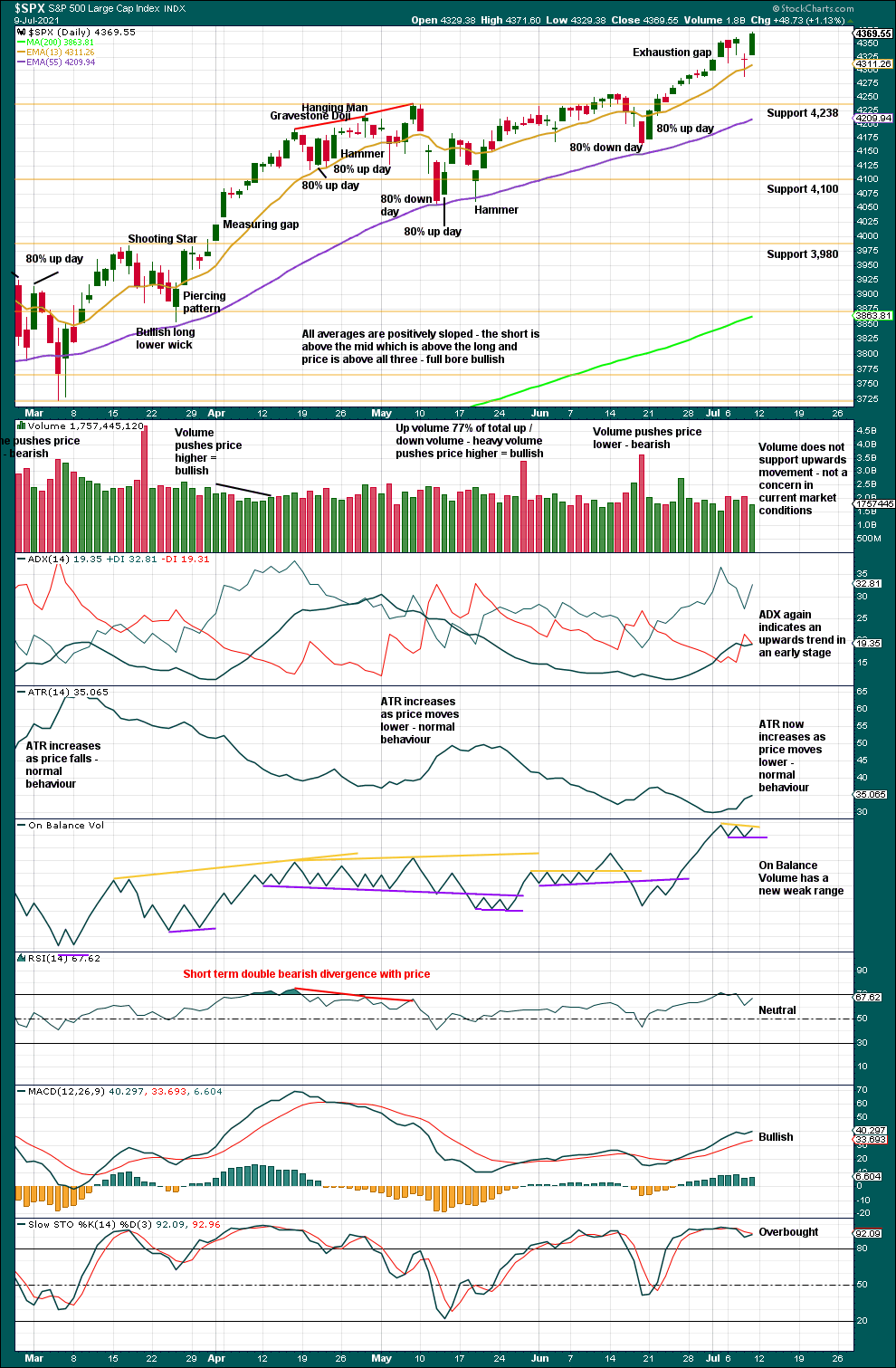
Click chart to enlarge. Chart courtesy of StockCharts.com.
With the last gap created on Thursday and closed on Friday, it would correctly be viewed as a pattern gap. The pullback following the exhaustion gap may be complete.
On Balance Volume may give an indication of the next short-term direction. An upwards breakout on Monday would be bullish. If it remains constrained, then price may continue sideways before an upwards breakout occurs.
BREADTH – AD LINE
WEEKLY CHART
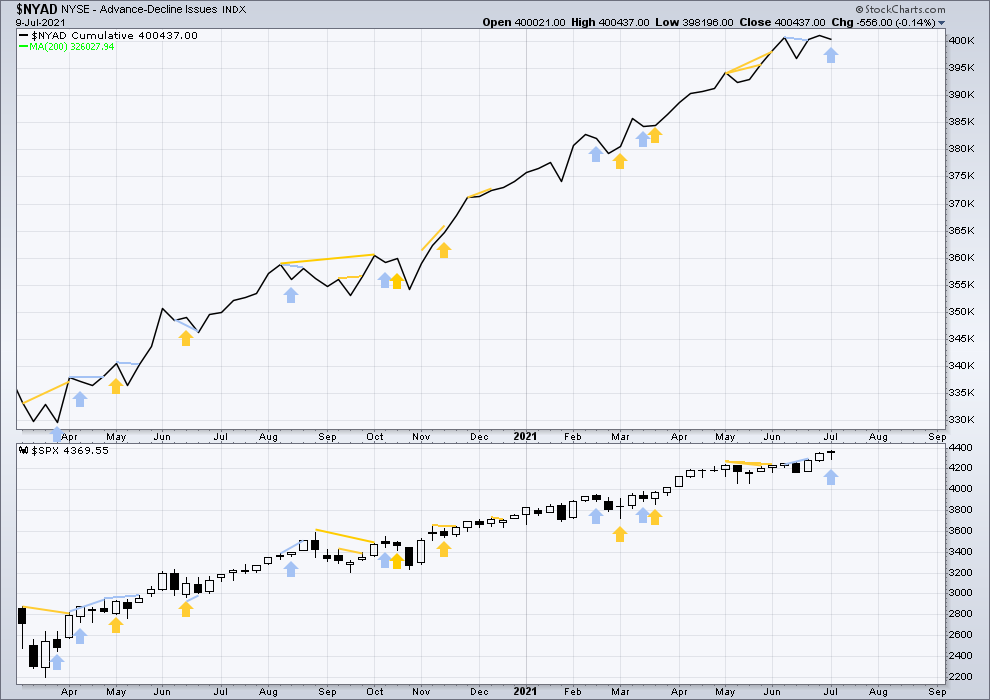
Click chart to enlarge. Chart courtesy of StockCharts.com. So that colour blind members are included, bearish signals will be noted with blue and bullish signals with yellow.
Breadth should be read as a leading indicator.
Lowry’s Operating Companies Only AD line has made a new all time high on the 8th of June. There is now a month of bearish divergence between the OCO AD line and price.
Large caps all time high: 4,371.60 on Jul 09, 2021.
Mid caps all time high: 2,778.84 on April 29, 2021.
Small caps all time high: 1,417.45 on June 8, 2021.
This rise is led by large caps, which is a feature of an aged bull market. This fits the Elliott wave count that sees a fifth wave to end a third wave completing. This may continue for some time before a larger pullback arrives.
This week price has moved higher, but the AD line has moved lower. There is now a single week instance of bearish divergence.
DAILY CHART
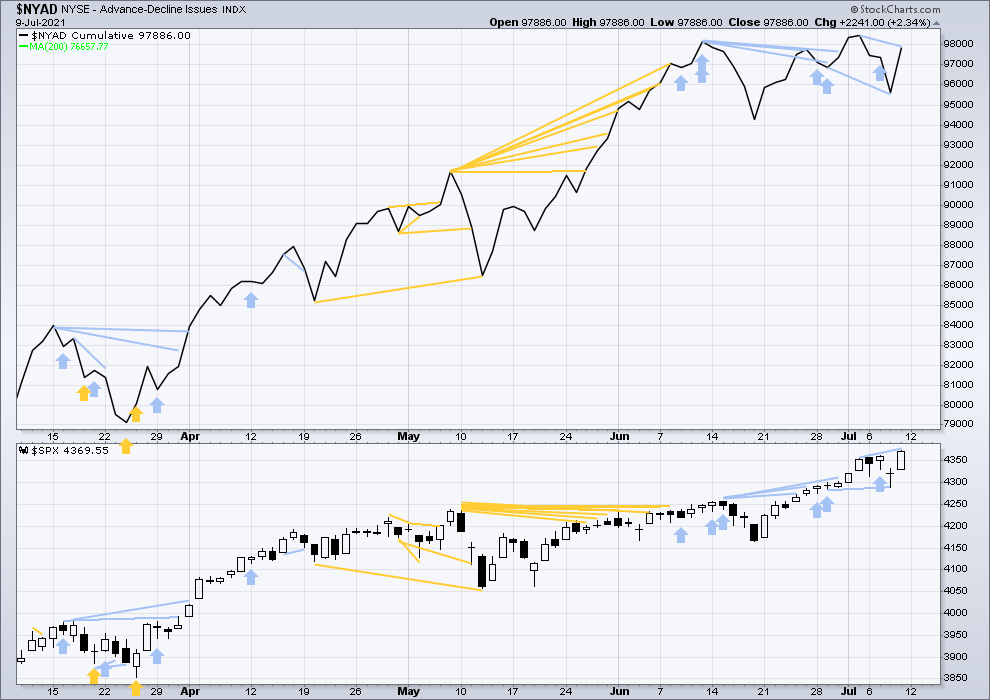
Click chart to enlarge. Chart courtesy of StockCharts.com. So that colour blind members are included, bearish signals will be noted with blue and bullish signals with yellow.
Today price has made a new all time high, but the AD line has not. There is short-term bearish divergence.
VOLATILITY – INVERTED VIX CHART
WEEKLY CHART
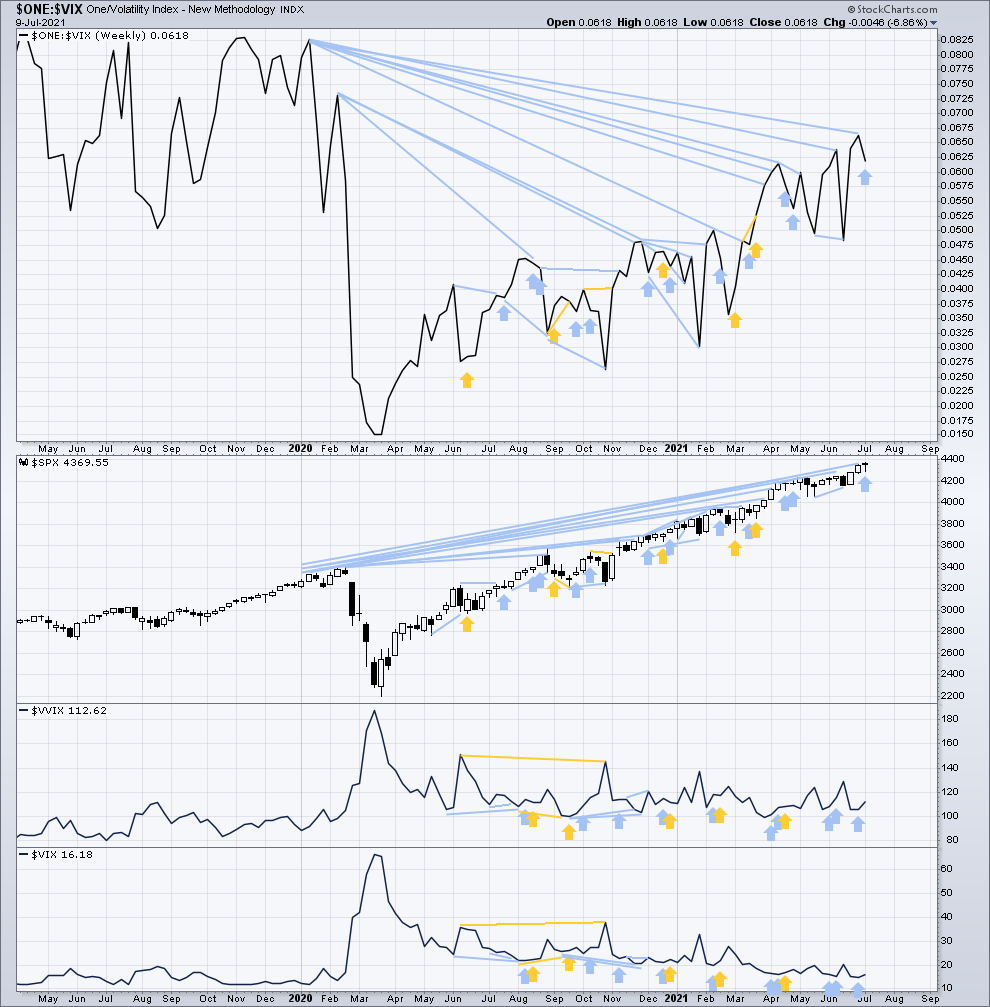
Click chart to enlarge. Chart courtesy of StockCharts.com. So that colour blind members are included, bearish signals will be noted with blue and bullish signals with yellow.
Inverted VIX remains well below all time highs. The all time high for inverted VIX was in the week beginning October 30, 2017. There is over 3 years of bearish divergence between price and inverted VIX. This bearish divergence may develop further before the bull market ends. It may be a very early indicator of an upcoming bear market, but it is not proving to be useful in timing.
This week price has moved higher, but inverted VIX has moved lower. This is a single week instance of bearish divergence. Mid-term bearish divergence remains.
Comparing VIX and VVIX at the weekly chart level:
This week both VIX and VVIX have moved higher. There is no new short-term divergence.
DAILY CHART
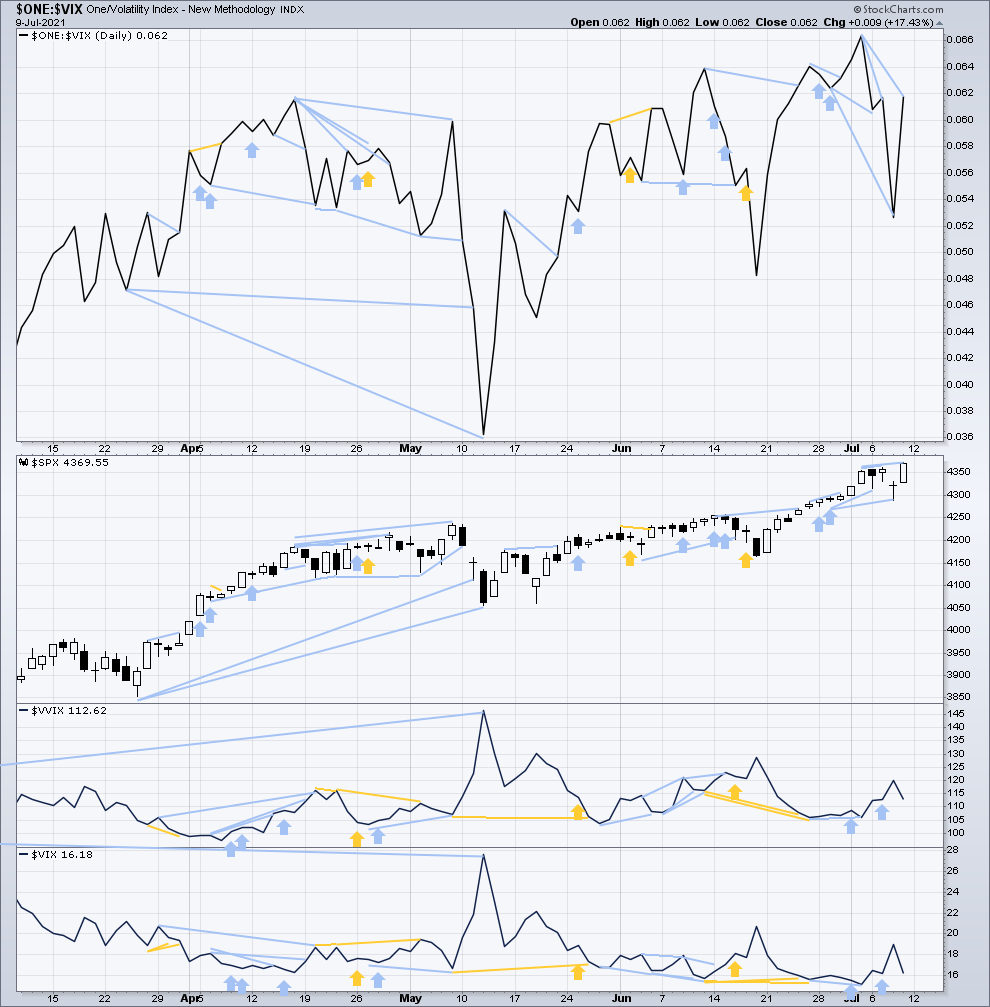
Click chart to enlarge. Chart courtesy of StockCharts.com. So that colour blind members are included, bearish signals will be noted with blue and bullish signals with yellow.
On Friday price has made a new all time high, but inverted VIX has not. There is now all of short, mid and long-term bearish divergence.
Comparing VIX and VVIX at the daily chart level:
On Friday both VIX and VVIX have moved lower. There is no new short-term divergence.
On 2nd July VIX made a new short-term low below the 25th of June, but VVIX did not. This divergence is bearish for price for the short term, but it is reasonably weak.
DOW THEORY
Dow Theory confirms a new bull market with new highs made on a closing basis:
DJIA: 29,568.57 – closed above on 16th November 2020.
DJT: 11,623.58 – closed above on 7th October 2020.
Most recently, on 10th May 2021 both DJIA and DJT have made new all time highs. An ongoing bull market is again confirmed by Dow Theory.
Adding in the S&P and Nasdaq for an extended Dow Theory, confirmation of a bull market would require new highs made on a closing basis:
S&P500: 3,393.52 – closed above on 21st August 2020.
Nasdaq: 9,838.37 – closed above on June 8, 2020.
The following major swing lows would need to be seen on a closing basis for Dow Theory to confirm a change from bull to a bear market:
DJIA: 18,213.65
DJT: 6,481.20
Adding in the S&P and Nasdaq for an extended Dow Theory, confirmation of a new bear market would require new lows on a closing basis:
S&P500: 2,191.86
Nasdaq: 6,631.42
Published @ 06:23 p.m. ET.
—
Careful risk management protects your trading account(s).
Follow my two Golden Rules:
1. Always trade with stops.
2. Risk only 1-5% of equity on any one trade.
—
New updates to this analysis are in bold.
—

